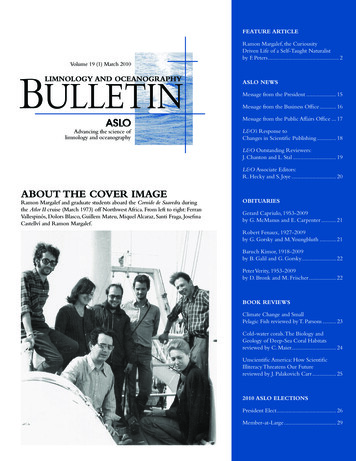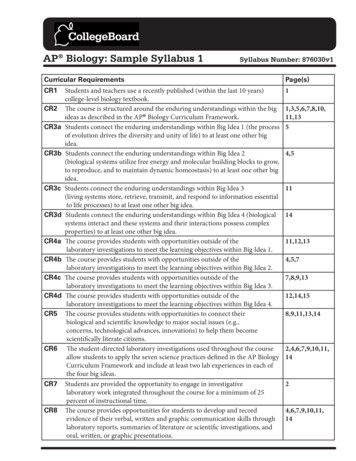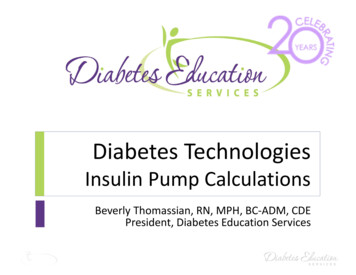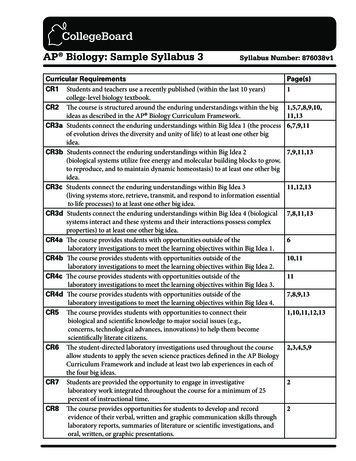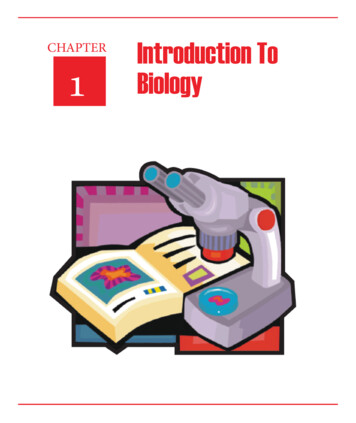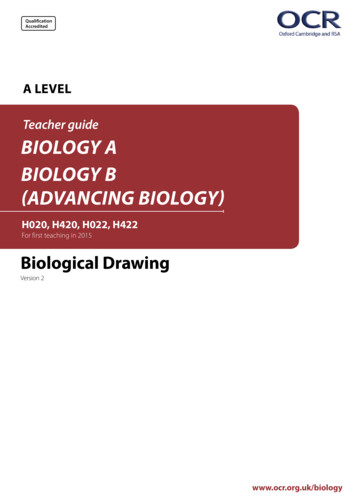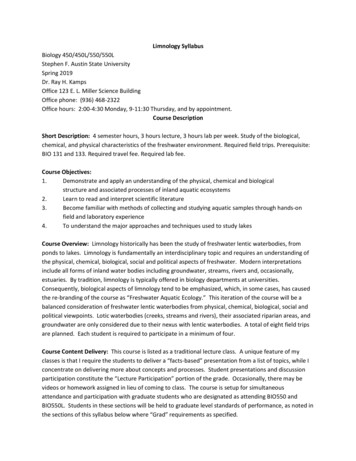
Transcription
Limnology SyllabusBiology 450/450L/550/550LStephen F. Austin State UniversitySpring 2019Dr. Ray H. KampsOffice 123 E. L. Miller Science BuildingOffice phone: (936) 468-2322Office hours: 2:00-4:30 Monday, 9-11:30 Thursday, and by appointment.Course DescriptionShort Description: 4 semester hours, 3 hours lecture, 3 hours lab per week. Study of the biological,chemical, and physical characteristics of the freshwater environment. Required field trips. Prerequisite:BIO 131 and 133. Required travel fee. Required lab fee.Course Objectives:1.Demonstrate and apply an understanding of the physical, chemical and biologicalstructure and associated processes of inland aquatic ecosystems2.Learn to read and interpret scientific literature3.Become familiar with methods of collecting and studying aquatic samples through hands-onfield and laboratory experience4.To understand the major approaches and techniques used to study lakesCourse Overview: Limnology historically has been the study of freshwater lentic waterbodies, fromponds to lakes. Limnology is fundamentally an interdisciplinary topic and requires an understanding ofthe physical, chemical, biological, social and political aspects of freshwater. Modern interpretationsinclude all forms of inland water bodies including groundwater, streams, rivers and, occasionally,estuaries. By tradition, limnology is typically offered in biology departments at universities.Consequently, biological aspects of limnology tend to be emphasized, which, in some cases, has causedthe re-branding of the course as “Freshwater Aquatic Ecology.” This iteration of the course will be abalanced consideration of freshwater lentic waterbodies from physical, chemical, biological, social andpolitical viewpoints. Lotic waterbodies (creeks, streams and rivers), their associated riparian areas, andgroundwater are only considered due to their nexus with lentic waterbodies. A total of eight field tripsare planned. Each student is required to participate in a minimum of four.Course Content Delivery: This course is listed as a traditional lecture class. A unique feature of myclasses is that I require the students to deliver a “facts-based” presentation from a list of topics, while Iconcentrate on delivering more about concepts and processes. Student presentations and discussionparticipation constitute the “Lecture Participation” portion of the grade. Occasionally, there may bevideos or homework assigned in lieu of coming to class. The course is setup for simultaneousattendance and participation with graduate students who are designated as attending BIO550 andBIO550L. Students in these sections will be held to graduate level standards of performance, as noted inthe sections of this syllabus below where “Grad” requirements as specified.
Course Specifics:Title: Limnology (Biology 450/550) and Limnology Lab (Biology 450L/550L)Textbooks: All materijali oncept-bookzz-org.pdfCredit Hours: 4 (3 hours lecture/1 hour lab)Grading for BIO450 & BIO450L: This course has an integrated lecture and lab grade.Exam 110%Exam 210%Exam 310%Final Exam20%Lecture Participation15%Quizzes10%Lab/Field trip25%Biology 550 and 550L are designed to be approximately 20% more rigorous than the senior level course.Graduate students will take the same exam as the undergraduates, but the score will be scaled down by20% and supplemented by a graduate student specific questions. For the student presentations,graduate students will choose the lake to present after the undergraduates have had a chance to choose,and will need to be the first to present. For the Lab and Field trips, graduate students will be required toperform at a higher level and assist the instructor with preparations and logistics, to be negotiated. Thismay include driving a van, proctoring a lab practical, planning and executing a research project, and/orassisting undergraduate students.Grading for BIO550 & BIO550L: This course has an integrated lecture and lab grade.Exam 110% (8% with rest of class and 2% grad specific)Exam 210% (8% with rest of class and 2% grad specific)Exam 310% (8% with rest of class and 2% grad specific)Final Exam20% (16% with rest of class and 4% grad specific)Lecture Participation15% (Last choice, first presentation)Quizzes10%Lab/Field trip25% (Additional requirements as specified above)
Preliminary scheduleModule 1: Fundamentals of Limnology.Emphasis is on vocabulary terms used in Limnology and looking at lakes as more than a hole in the ground filled with water. These terms arenecessary for use in the student presentations later in the semester and in lab. The “textbook” df . If this becomes unavailable online, I will make it available via D2L.1/231/281/302/42/62/11Lecture 1: Course OrientationLecture 2: Physical LimnologyPages 1-14Lecture 3: Chemical LimnologyPages 15-18, Additional material on Reservoirs.Lecture 4: Biological LimnologyPages 19-40Lecture 5: Biological Limnology continuedLecture period 6: Exam I, Fundamentals of LimnologyModule 2: General LimnologyEmphasis is on understanding processes. Expect to be reading and interpreting complex diagrams, performing calculations, and diagrammingprocesses. Also, student presentations will begin in this module. The “Textbooks” 3/limnology-kalff.pdf and https://www.bio.bg.ac.rs/materijali ncept-bookzz-org.pdf . If these become unavailable online, I will make them available via D2L.2/13: Lake PresLecture 7: Introduction, Scope and HistoryKalff Chapters 1&2, selected readings2/18: Lake PresLecture 8: Water is weird.Kalff Chapter 32/20: Lake PresLecture 9: Water Resources and HydrologyKalff Chapter 4&5, selected readings2/25: Lake PresLecture 10: Lake Origin & MorphometryKalff Chapters 6&7, selected readings2/27: Lake PresLecture 11: Inputs to lakesKalff Chapters 8&9, selected readings3/4: Lake PresLecture 12: Lake physicsKalff Chapters 10, 11 and 12, selected readings3/6: No PresOnline Lecture 13 and problem set. Watch D2L carefully as this may change.3/11: Exam II: Geo-Physical Limnology3/13: No PresOnline lecture (un-numbered): Contemporary Issue in Limnology, Topic and readings TBA [From module 3] SPRING BREAK
3/25: Lake PresLecture 14: Lake chem I, Major Constituents3/27: Tx Lake PresLecture 15: Lake chem I, continued4/1: Tx Lake PresLecture 16: Lake chem II, Minor Constituents4/3: Tx Lake PresLecture 17: Microbial/chemical connections4/8: Tx Lake PresLecture 18: Phytoplankton4/10: Tx Lake PresLecture 19: Phytoplankton, continued4/15: Tx Lake PresLecture 20: Zooplankton4/17: Tx Lake PresLecture 21: Nekton and Food Chains4/22: Exam III: Chemical and Biological LimnologyKalff Chapters 13, 14, 15, 16 selected readingsKalff Chapters 17, 18, 19, 20 selected readingsKalff Chapter 21Kalff Chapter 23Kalff Chapters 24, 25, 26, selected readingsModule 3: Contemporary Topics in LimnologyEmphasis is on water management as a resource for humans. The “Textbook” will consist of research papers, white papers, government reports,and news articles. This module is highly reactive to current events and the interests of the students in the class, and so the following schedule isonly ad hoc. Students should submit topic ideas throughout the semester.4/24: Lecture 22: Is water a right?--minimum water required--water rights in Texas4/29: Lecture 23: Flood control and drinking water supply reservoirs.--Dams and levies, dry and wet ponds.--Contaminants and concerns in drinking water, focus on Aquila, Texas and Flint, Michigan.5/1: Lecture 24: Invasive species--The big baddies: Asiatic clams, zebra mussels, giant salvenia, hydrilla, water hyacinth,lamprey eels, Asiatic carp--What is an invasive species in an artificial lake?5/6: TBA5/8: Dead Day (No class meeting, students are invited to discuss their standing in the class in my office.)Final Exam: Contemporary topics and Comprehensive
Course Policies:This course adopts all Stephen F. Austin State University policies and they are reprinted below in the“Standard Policies” section below. I especially invite anyone with disabilities to take advantage ofDisability Services. I have 2 disabilities myself and will work with Disability Services to ensure thatappropriate accommodations are provided.Generally, I expect students taking a senior-level or graduate-level course to treat this as a professionaljob. I expect you to be on time. I expect advanced notification when you are going to be late and areasonable explanation, with documentation. I expect advanced notification when you are going to beabsent and a reasonable explanation, with documentation. D2L Brightspace is my primary method ofcommunicating with students in the class. Students should check D2L Brightspace DAILY for news itemsand quizzes.If we enter into any verbal agreement, it is provisional until it is agreed to in writing in an email. Forinstance, if we agree to move your presentation to a different day, you must email me for confirmationand I must confirm it before it is effective. The reason for this is that I wish to be very specific about thecommunication and be able to double check the calendar to make sure that our agreement is workable.Without that written agreement, you would receive a penalty for failing to give your presentation ontime.Major exams will generally be 80% Scantron and 20% essay answer. For the final exam, the essayanswer portion may not be graded if full credit on that portion will not change your final grade. You arewelcome to come by after final grades are submitted to review your final exam. If you find anycreditable mistakes that will change your final course grade, I am happy to submit a grade change form.Makeups/Latework/Extensions/Exceptions: During the course of the semester, I will occasionally allowstudents to makeup missed assignments due to documented extenuating circumstances and inaccordance with SFASU policy. If you wish to do this, you must contact me at the very first opportunitythat you have to do so. Methods of contact include by email, by phone or in person during office hours.It is my choice whether to allow any sort of a makeup and what sort of makeup. For instance, if youmissed a major exam, I could decide to give you a different exam from the rest of the class. If I allow amakeup, the deadline for turning in the missed assignment is two weeks, unless otherwise specified inan email. A 10% per day penalty will be assessed against any late work turned in withoutdocumentation of extenuating circumstances. The penalty may be prorated at my discretion.Standard Policies:Evaluations and surveys: It is now departmental policy to require students to fill out online classevaluations at the semester’s end (instructions will be provided at a later date).Acceptable Student Behavior: Classroom behavior should not interfere with the instructor’s ability toconduct the class or the ability of other students to learn from the instructional program (see theStudent Conduct Code, policy D-34.1, http://www.sfasu.edu/policies/student conduct code.asp).
Unacceptable or disruptive behavior will not be tolerated. Students who disrupt the learningenvironment may be asked to leave class and may be subject to judicial, academic or other penalties.This prohibition applies to all instructional forums, including electronic, classroom, labs, discussiongroups, field trips, etc. The instructor shall have full discretion over what behavior isappropriate/inappropriate in the classroom. Students who do not attend class regularly or who performpoorly on class projects/exams may be referred to the Early Alert Program. This program providesstudents with recommendations for resources or other assistance that is available to help SFA studentssucceed.***Class etiquette (negative)***Do not be late for class.Do not leave before the class period is over.Do not anticipate the end of class and start putting your things away.Do not talk socially during class.Use of electronic devices is restricted to enhancing the learning process and minor, unobtrusive use, ordocumented need (i.e. disability. Please see instructor)***Class etiquette (positive)***Come on-time to class and be prepared to be awesome!Grace us with your awesomeness all the way to the end of class!If you have questions or comments about Biology, I want to hear them!Please use your cell phone, tablet, laptop, or other electronic device during class to enhance yourlearning opportunity!Academic Integrity (A-9.1): Abiding by university policy on academic integrity is a responsibility of alluniversity faculty and students. Faculty members must promote the components of academic integrityin their instruction, and course syllabi are required to provide information about penalties for cheatingand plagiarism as well as the appeal process.Definition of Academic DishonestyAcademic dishonesty includes both cheating and plagiarism. Cheating includes, but is not limited to: using or attempting to use unauthorized materials to aid in achieving a better grade on acomponent of a class;falsification or invention of any information, including citations, on an assignment; and/or,helping or attempting to help another in an act of cheating or plagiarism.Plagiarism is presenting the words or ideas of another person as if they were your own. Examples ofplagiarism include, but are not limited to:
submitting an assignment as if it were one's own work when, in fact, it is at least partly thework of another;submitting a work that has been purchased or otherwise obtained from the Internet oranother source; and,incorporating the words or ideas of an author into one's paper or presentation withoutgiving the author due credit.Procedure for Addressing Student Academic DishonestyA faculty member who has evidence and/or suspects that academic dishonesty has occurred shall gatherall pertinent information, approach the student(s) involved, and initiate the following procedure: The faculty member shall review all evidence of cheating or plagiarism and discuss it directlywith the student(s) involved. The faculty member shall inform the student(s) of theprocedure for addressing academic dishonesty, as well as the appeals process.After hearing the student(s)' explanation or defense, the faculty member will determinewhether or not academic dishonesty has occurred and will inform the student(s) whataction will be taken. Penalties may include reprimand, no credit for the assignment or exam,re-submission of the work, make-up exam, or failure of the course. The faculty member mayconsult with the academic unit chair/director and dean in making these decisions.After a determination of academic dishonesty, the faculty member shall notify the office ofthe dean of the student's major by submitting a Report of Academic Dishonesty, along withsupporting documentation as noted on the form. This report shall be made part of thestudent's record and shall remain on file with the dean's office for at least four years.Upon second or subsequent offenses, the dean of the student’s major will determine acourse of action, which may include dismissal from the university. The dean may refer thecase to the college council for review and recommendations before making thisdetermination.A student's record of academic dishonesty will not be available to faculty members. The purpose of therecord is for the dean to track a pattern of academic dishonesty during a student's academic career atStephen F. Austin State University.Students who are found to have demonstrated academic dishonesty and have withdrawn prior to theaward of a grade will continue to have the determination of the infraction within their student records.Student AppealsA student who wishes to appeal decisions related to academic integrity should follow proceduresoutlined in Academic Appeals of Students (A-2).Withheld Grades Semester Grades Policy (A-54): At the discretion of the instructor of record and withthe approval of the academic chair/director, a grade of WH will be assigned only if the student cannotcomplete the course work because of unavoidable circumstances. Students must complete the workwithin one calendar year from the end of the semester in which they receive a WH, or the grade
automatically becomes an F. If students register for the same course in future semesters, the WH willautomatically become an F and will be counted as a repeated course for the purpose of computing thegrade point average. Special note: A grade of WH is almost impossible for this class because mycontract ends May 30th. If this is something that you need, do not delay to set it up with me and thedepartment. I will do whatever I can.Students with Disabilities: To obtain disability related accommodations, alternate formats and/orauxiliary aids, students with disabilities must contact the Office of Disability Services (ODS), HumanServices Building, and Room 325, 468-3004 / 468-1004 (TDD) as early as possible in the semester. Onceverified, ODS will notify the course instructor and outline the accommodation and/or auxiliary aids to beprovided. Failure to request services in a timely manner may delay your accommodations. Foradditional information, go to http://www.sfasu.edu/disabilityservices/.Copyright notice: Most of the material in this course is copyrighted and either used with permission orused under the educational “fair use” doctrine. The permissions and “fair use” doctrine both requirethat the material not be made available publicly. Additionally, there is a reasonable expectation ofprivacy by the students in the class and/or the instructor in some circumstances. Students areprohibited from recording audio and video and subsequently sharing it on social media sites. (Theinstructor is prohibited from doing this too.)
Lab Syllabus:Laboratory and Field Trip Policies: The university requires that you fill out and sign two documents forparticipation on the field trips. They are said to be voluntary because you volunteered to take the class(Limnology is not an absolute requirement on any degree plan that I know of.) The first one is a waiverof liability. The university has a great deal of control over the educational environment while you are oncampus, but that control decreases considerably anywhere off campus. It decreases even more duringfield trips to places without roads (such as in the middle of a lake). There are significant dangers totraveling to a lake and motoring out in the middle to take measurements. These dangers includeautomotive accidents, boating accidents, inclement weather, bites from wildlife, or exposure topoisonous plants. You are agreeing to not hold me or the university liable for any of these potentialproblems. The second form is your insurance information and permission for treatment in case you areinjured on a field trip. This form is only effective if you are unconscious. It allows me to authorize adoctor to treat you until your designated next-of-kin or other person holding medical power of attorneytakes over, or you wake up.Specifically for field trips: if you are a “No Show” for the field trip, you will receive a zero and not beeligible to make it up. If you are a “No Show” twice during the semester for field trips, you will receivean “F” for the entire course grade. A “No Show” is defined as someone who provided no advancednotification that they couldn’t make it. You should attempt to contact me many different ways if youcan’t make it to a field trip that you are signed up for. You should call and leave a message on my officephone. You should call and leave a message with the department (don’t just accept a transfer to myoffice phone, ask them to text or call my personal cell phone, they have the number). You shouldexchange telephone numbers with someone else on the trip and call them if you can’t make it. Youshould email me. Being a “No Show” on a field trip is a big deal. IF YOU ARE IN JAIL AND ONLY HAVEONE PHONE CALL, MAKE SURE THAT YOUR BEST FRIEND, BROTHER, SISTER, PARENT, SIGNIFICANTOTHER OR WHOMEVER YOU CALL TO BAIL YOU OUT CONTACTS ME AS WELL. If you are in an accidenton your way to the field trip and there is no way to contact me, take a screenshot of your phoneshowing no service bars and take several photos of the accident and send them all to me when you getservice. We can negotiate.
Tentative Lab/Field Trip ScheduleBe forewarned that labs and field trips will be rescheduled as needed to adjust for inclement weather. Ican cancel and reschedule a field trip even after launching the boat with everyone onboard. PLAN TOATTEND EVERY LAB/FIELD TRIP SESSION, EVEN IF YOU ARE NOT SCHEDULED. SHOW UP ON TIME TOCONFIRM THAT I HAVEN’T RESCHEDULED A LAB FOR THAT DAY.01/23 Laboratory orientation01/30 Basic microscopy, water sampling and water quality analysis, followed by exam.--50% general participation.--50% exam grade.02/06 Walking field trip to AgPond, followed by lab work.--50% general participation.--50% narrative summary.02/13 Off-campus field trip 1 Pond (others meet in lab)02/20 Off-campus field trip 2 Lake Naconiche (others meet in lab)02/27 Off-campus field trip 3 Lake Nacogdoches (others meet in lab)03/06 Off-campus field trip 4 Upper Sam Rayburn Reservoir (others meet in lab)03/13 Off-campus field trip 5 Lower Sam Rayburn Reservoir (others meet in lab)03/20 SPRING BREAK! (I won’t reschedule this)03/27 Off-campus field trip 6 Pond (others meet in lab)04/03 Off-campus field trip 7 Lake Naconiche (others meet in lab)04/10 Off-campus field trip 8 Lake Nacogdoches (others meet in lab)04/17 Computer lab: Limiting nutrients--50% Worksheet--50% quiz04/24 Computer lab: TBA, but likely to be a “Water on the Web” exercise.--50% Worksheet (or equivalent)--50% quiz (or equivalent)05/01 Lab Final exam.05/08 Research Report is due.Grading:4 Lab meeting grades:4 Field trip grades:4 Field trip summaries:--Includes lab work!Lab Final Exam20% [23%, if no lab final]20% [23%, if no lab final]20% [24%, if no lab final]10%[may be cancelled, in which case thebracketed percentages above apply]Group Research Report30% [undergrads][Grads: 20% for yours, plus 10% for the undergrad group research report for which they are a part of]
Student(driver)1Pond 1 Naconiche 1Nacogdoches 1Upper Sam RayburnLower Sam RayburnPond 2Naconiche 2Nacogdoches 22345 8 7 6 910Grad1Grad2Lab Grad Students 1-3 will be going on the Lower Sam Rayburn Field Trip plus 1 more.Students 4-6 will be going on the Upper Sam Rayburn Field Trip plus 2 more.Students 7-10 will be going on a total of 4 field trips. If more students are forced into the class, I will just need to work them into the schedule.Research Reports:PondNaconicheNacogdochesAll ThreeComparison and TimeComparison and TimeComparison and TimeTime and SizeStudents 1, 4, 7, (12) GradStudents 2, 5, 8, (11) GradStudents 3, 6, 9, 10GradAll Graduate Students
dodds-freshwater-ecology-concept-bookzz-org.pdf . If these become unavailable online, I will make them available via D2L. 2/13: Lake Pres Lecture 7: Introduction, Scope and History Kalff Chapters 1&2, selected readings 2/18: Lake Pres Lecture 8: Water is weird. Kalff Chapter 3 2/20: Lake Pres Lecture 9: Water Resources and Hydrology Kalff Chapter 4&5, selected readings 2/25: Lake Pres Lecture .
